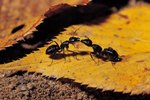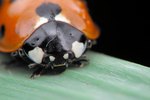
Brightly colored red, orange or yellow and sporting fun spots, ladybugs are one of the prettiest members of the beetle family. Sometimes called ladybirds, there are more than 500 kinds of ladybugs in the United States alone. Beneath their polka-dot exterior, ladybugs have a set of wings that allows them to fly.
Elytra
Like most beetles, ladybugs have a tough shell protecting their delicate wings called the elytra. In the case of the ladybug, the elytra is colored from red to yellow with black spots. Ladybugs can have anywhere from 2 to 13 spots decorating their shell. The reason they have such a colorful exterior is to warn off would-be predators, since ladybugs have a bitter taste.
Taking Flight
The elytra are hinged to the pronotum, the section just beneath the ladybug’s head. When the ladybug flies, the elytra lift up to allow the gossamer wings beneath to unfold. The wings flap quickly from front to back, at a speed of 85 times every second. When the ladybug lands, the wings fold neatly back underneath the elytra.
Ladybug Life Cycle
While commonly called ladybugs, they aren’t technically bugs. They are part of the order coleoptera, making them lady beetles. Members of this order go through a complete metamorphosis. Hatching from eggs, ladybugs are in the larva stage for a month where they eat and grow. They go into the pupal stage for around two weeks before emerging as full-grown ladybugs. Ladybugs can only fly as adults and live for roughly a year.
Farmer's Best Friend
If you find ladybugs making themselves at home in your garden consider yourself lucky. Ladybugs favorite food are tiny insects called aphids that can lay waste to plants and crops. Many species of ladybug from other countries, like Australia, have intentionally been introduced to the U.S. for the purpose of controlling aphid populations. Ladybugs hibernate during the winter, and you may find that ladybugs have made themselves at home in the warm recesses of your house. Ladybugs won’t harm you or your home, and will happily leave once the weather warms.
References
Photo Credits
-
John Foxx/Stockbyte/Getty Images




